#Textile Auxiliaries
Text
Contact: 8866868394
Email: [email protected]
Website
#textile finishing chemicals manufacturers#textile dyes auxiliaries#textile finishing chemicals#textile dyes manufacturers#textile auxiliaries#textile finishing chemicals suppliers#aesthetic finish in textile
0 notes
Text

Sophie Seita, These Devices Became Law, (textile piece (digital pigment ink print on 100% cotton gauze in two pieces, top: 136x133cm in 112gsm; and bottom: 99x43cm in 125gsm); and performance), 2024 [© Sophie Seita. Photos: Laura Cobb]







Events/Performances: Akademie der Künste, Berlin, May 2024; The Auxiliary, Middlesbrough, for Middlesbrough Art Weekender, September 2024
#art#textile#drawing#visual writing#performance#sophie seita#laura cobb#akademie der künste#the auxiliary#the auxiliary project space#2020s
19 notes
·
View notes
Text
Auxiliaries for Textile Industry in Delhi | Textile Chemicals
Auxiliaries For Textile Industry In Delhi
Are you in search of high-quality auxiliaries for the textile industry? Look no further! Welcome to our premier service for textile auxiliaries in Delhi. The textile industry encompasses a wide array of materials, from yarns to various fabrics, fibers, and finished articles. Each requires specialized solutions for their chemical processing, and we are here to provide exactly that. Our range of products is diverse, catering to the unique needs of textile manufacturers. textile auxiliary producer Delhi
Why Choose Us?
As leading textile auxiliaries manufacturers in Delhi, we pride ourselves on several key points:
Diverse Product Range: We offer more than just a single product; our catalogue boasts a wide variety of auxiliaries for chemical processing.
Versatility: Our products cater to a range of fabrics and fibers, ensuring we are not limited to one specific type.
Quality: All our products are of exceptional quality, designed for optimal performance and excellent results.
Multi-Purpose: Whether it's dyeing, printing, or other fabric treatments, our auxiliaries are versatile and effective.
Comprehensive Solutions: Consider us your one-stop solution for all textile processing requirements.
These aspects set us apart as premier textile auxiliary producers.
Our Categories of Auxiliaries
Here's a glimpse into some of the textile industry auxiliaries we offer in Delhi:
Pretreatment Auxiliaries
Our pretreatment auxiliaries boast highly absorbent and low-foaming formulations, with impressive binding capabilities. They are eco-friendly, GOTS approved, and free of APEO/NPEO. Examples include Scowet TT Conc., Rikoclean – STR, and Trinitron. These auxiliaries include stain removers tailored for synthetic and natural fibers, such as Rikoclean – STR.
Dyeing Auxiliaries
Our dyeing auxiliaries feature excellent levelling properties, ensuring uniform distribution of dye. They offer high soaping and washing-off abilities, all while being GOTS approved. For instance, Milaniaks- R serves as a cationic retarder for controlled and uniform acrylic dyeing. Additionally, Trinitron – LTS is a low-temperature washing off agent suitable for various fibers, providing excellent soaping fastness and easy wash.
Finishing Agents
Our finishing agents consist of both silicone and non-silicone specialty softeners, crafted to meet the industry's specific needs. These auxiliaries are invaluable, offering versatile finishes tailored to the desired garment or fabric. From exhaustible to inexhaustible finishes, as well as hydrophobic and oleo phobic options, our range covers a spectrum of textile chemicals and auxiliaries in Delhi.
If you're in need of top-notch textile auxiliaries, don't hesitate to reach out to us today. We are your partners in achieving exceptional textile processing results.
#auxiliaries for textile industry in Delhi#textile auxiliaries manufacturers Delhi#textile auxiliary producer Delhi
0 notes
Text

Textile Dyeing Chemicals & Auxiliaries | Dyeing Agent - Sarex
0 notes
Text
How Textile Chemical Dyes Impact the Environment?
In the vibrant world of fashion and textiles, colors play a pivotal role in capturing our imagination and defining our sense of style. The captivating hues of our garments owe their brilliance to a significant yet often overlooked aspect of the industry: chemical dyes.
These dyes have revolutionized the textile sector, making it possible to produce a wide array of colors and patterns that appeal to consumers' ever-changing tastes. However, amidst this rainbow of possibilities lies a dark truth - the environmental impact of textile chemical dyes.
In this blog, we delve into the consequences of using chemical dyes in textile production and explore sustainable alternatives that can help mitigate the ecological footprint of the fashion industry.

Water Pollution
One of the most significant environmental concerns associated with chemical reactive dyes in textiles is water pollution. Conventional dyeing processes often involve large amounts of water, which is used to rinse and treat fabrics. As a result, vast quantities of chemically-laden wastewater are discharged into rivers and water bodies, contaminating aquatic ecosystems. Many of these dyes are non-biodegradable and can persist in the environment for decades, disrupting the natural balance and threatening the health of aquatic organisms.
Energy Consumption
The process of digital textile sublimation inks requires substantial energy inputs, primarily during the dye application and fixation stages. Traditional dyeing methods may involve high-temperature dye baths and extended processing times, adding to the industry's carbon footprint. The energy-intensive nature of these processes contributes to greenhouse gas emissions, accelerating climate change and its devastating consequences.
Toxic Chemical Exposure
Chemical dyes used in textile auxiliaries manufacturers often contain hazardous substances such as heavy metals, formaldehyde, and volatile organic compounds (VOCs). Not only are these substances harmful to the environment, but they also pose significant health risks to the workers in the textile industry who are exposed to them daily. Moreover, consumers may experience allergic reactions and skin irritations when in contact with garments containing residual dye chemicals.
Biodiversity and Land Contamination
When dye wastewater finds its way into the soil, it can have severe consequences for terrestrial ecosystems. The toxic substances from the dyes can leach into the soil, affecting soil quality and disrupting the delicate balance of local flora and fauna. Moreover, the disposal of waste from dyeing processes can lead to the accumulation of harmful chemicals in landfills, further exacerbating the environmental impact.
Scarce Resource Consumption
Many chemical dyes rely on non-renewable resources for their production. For instance, some synthetic dyes use petroleum-based derivatives, placing additional strain on dwindling fossil fuel reserves. As these resources become scarcer, the textile industry must find more sustainable alternatives to safeguard the planet's future.
Embracing Sustainable Solutions
As we confront the ecological consequences of chemical dyes, the textile industry is gradually recognizing the urgent need for change. Embracing sustainable solutions can help mitigate the impact of dyes on the environment:
Natural Dyes: Traditional plant-based dyes, such as indigo, turmeric, and madder, offer a biodegradable and eco-friendly alternative. They can be sourced sustainably, reducing the strain on the environment.
Waterless Dyeing Technologies: Innovative technologies, like air dyeing and digital printing, minimize water usage and eliminate the discharge of wastewater, significantly reducing water pollution.
Biodegradable Dyes: Researchers are developing biodegradable dyes that break down naturally over time, circumventing the issue of persistent chemicals in the environment.
Eco-Friendly Dyeing Processes: Manufacturers can adopt low-impact dyeing techniques that consume less energy and minimize toxic chemical usage, ensuring a cleaner and safer environment for all.
The use of chemical dyes offers by textile printing ink exporter in the textile industry has undoubtedly made fashion more colourful and accessible. However, this innovation comes at a high cost to our environment. From water pollution to biodiversity loss, the impact of chemical dyes on the planet is far-reaching.
To ensure a sustainable future, it is imperative for the industry to embrace eco-friendly alternatives and implement responsible dyeing practices. By taking steps towards a more environmentally conscious approach, we can paint a brighter, greener canvas for the fashion world, where creativity and conscience coexist harmoniously.
#Textile Dyes Exporter#Textile Dyes Manufacturers#Textile Dyes Manufacturers in India#Digital Textile Reactive Inks#Digital Textile Printing Ink Manufacturer#Digital Textile Printing Ink Exporters#Textile Printing Ink Exporter#Digital Textile Sublimation Inks#Textile Auxiliaries Manufacturers#Textile Auxiliaries Exporter#Reactive Dyes Manufacturer#Reactive Dyes Exporter#Reactive Dyes Manufacturer in India#Textile Chemical Dyes
0 notes
Photo
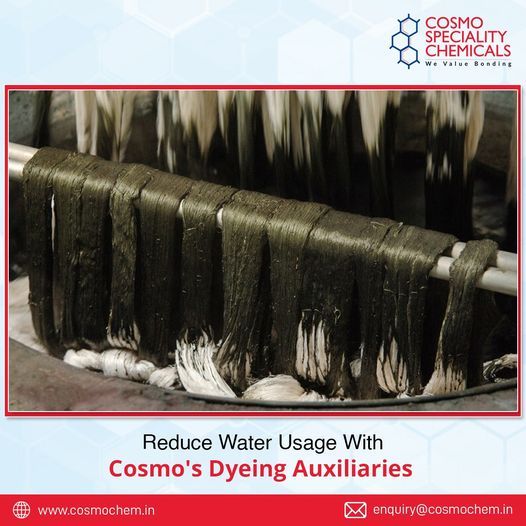
Water sustainability is the major issue today; however, with Cosmo Speciality Chemicals' dyeing auxiliaries you can make a significant impact. Save water with Cosmo's eco-friendly dyeing auxiliaries.
0 notes
Text
02/02/2024 Daily Recap
TLDR; SaveOFMDCrew Tumblr Updates; How To Help; Twitter Hashtags; Daily Lists; Reminders: Appreciation Events; Live Rewatch OFMD Party with Q+; Operation Auxiliary Wardrobe; Cast & Crew Sightings; New Watch Partys; Actually reasonable Articles; Stats; Petition Status; Morale; Love Notes; Daily Darby/Tonight's Taika
= Save OFMD Crew Tumblr Up =
The SaveOFMDCrew Tumblr is finally up and running! Due to some weirdness with accounts they'll be under @saveofmdcrewmates as opposed to the regular name. This will have the same news as the other platforms so feel free to give them a follow.

== How To Help ==
Twitter folks: looks like @SaveOFMDCrew as well as several other people who've been leading the charge on twitter wanted to remind everyone on when to use what hashtags. Apparently there's been some cross pollination and they wanted to try and clear it up. Thank you to @havethisonelife for summarising.

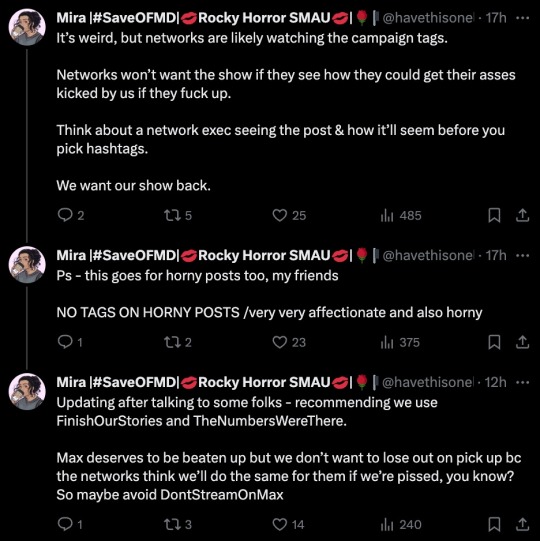
Haterade Posts:
#OhBloysHeMad , #TheNumbersWereThere, #FinishOurStories
Avoid: #DontStreamOnMax
When Advertising ourselves:
#SaveOFMD #AdoptOurCrew
Horny Posts:
No tags (Edit: @SaveOFMDCrew said it was ok to use #OurFlagMeansDeath on horny posts, just no other tags).
Suggestions for How to Help
Looking for ways to help? There are still daily ideas for you here:
How To Help Save OFMD Task List - US
How to Help Save OFMD Task List - Outside US
==Reminders!==
Cast Appreciation Events!

Tomorrow is Day of Damien! A day to shower Damien Gerard (Father Teach) with support and kindness for all he's done for our fandom! He has been hitting #SaveOFMD events pretty hard trying to support us!
When to start: Saturday February 3rd, 6 AM CST, 7 AM ET, 4 AM PT, 12 PM GMT
Hashtags: #DayOfDamien
His Social Media Accounts:
Linktree (has his cashapp, etc) / Instagram / Twitter / Twitch / Tiktok
== Live - Rewatch Party with Q+! ==
This rewatch party is particularly important because the crew is really trying to get people hyped for the BBC launch of s2 on Feb 5. Everyone is hoping that if the s2 launch in the UK shows huge interest it'll be a huge boon for the potential for s3 with the networks.
Sunday Feb 4, 2 PM GMT / 9 AM ET / 6 AM PT

Watch Party Hashtags:
#OurFlagMeansRewatch
#AdoptOurCrew
#SaveOFMD
#OurFlagBBC
=Operation Auxiliary Wardrobe=
Do you do applique, crochet, cross stitch, embroidery, knitting, needle felt or any other textile-based OFMD Art? Wanna join a fun group of participants? Starting next week there will be a recruiting drive for a new fabric+thread project mid-month if people are interested! If you want to jump in now you can message @ForceMonument on twitter, otherwise other avenues will be opened sometime in the coming weeks!
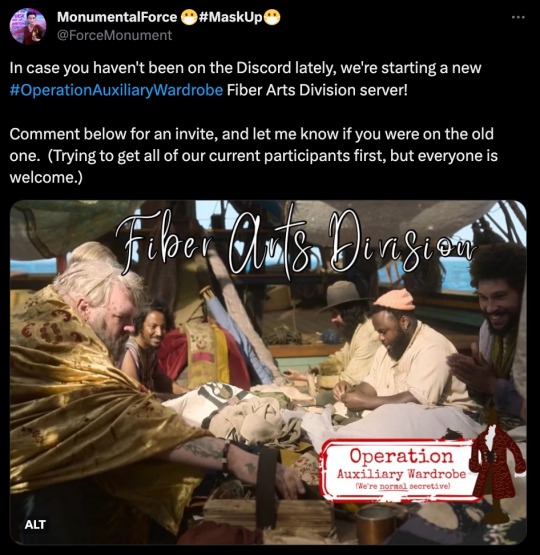

=Cast & Crew Sightings =
This is from 01/26/2024 but I missed it and I feel like it needs to be shared. Dominic Burgess being a goofball badass as Jeffrey Fettering singing a 18th century version of the Friends theme song. <3 (Apologies for the quality of the video, I had to record it off my screen so people didn't have to go to Twitter). Twitter Post.

Wee John Wednesdays Mondays are back!
Mon 5th Feb, 10.30pm on Kristian Nairn's Instagram

=NEW WATCH PARTIES =
You can see a running list of current/upcoming watch parties here.
Thank you @libbyroseitm for the new Watch Party!
Uncle Season 1 watch party on i-player.
Thurs 15th + Fri 16th Feb (GMT - 8 PM , ET - 3PM, PST - 12 PM)

Catered specifically for the UK crew, but we'd be thrilled for anyone else using VPN's to join in too! Here's an article on how to join via VPN
WatchParty Hashtags:
#ForTheNewUncle
#SaveOFMD
#AdoptOurCrew
== Articles ==
Finally! The Q+ Article is wonderful and very uplifting.
Our Flag Means Death: Why It Deserves to Find a New Harbor
The 10 best TV shows to watch this week, from Mr and Mrs Smith to One Day
Hairy Bikers Go West, Death In Paradise and Wheel of Fortune: TV highlights this week
The Uncertain Fate of “Our Flag Means Death” Season 3: A Closer Look
Every show canceled so far in 2024
Netflix adds one of ‘the best shows of 2022’ after it was dropped by HBO Max
== STATS ==
Thanks to @Seven_Sugars over on twitter for this info and analysis.




Also, as always, more fun stats from @meowzawowza on twitter from the Netherlands.

== Petition Status ==
Almost to 84K signatures friends!

== Morale ==
I know we're ending day 24 of being the Gravy Basket. It's been a lonnnnng several weeks. We haven't heard from chaos dad in around a week now, so it may seem again like things are slowing down again.
As several folks have mentioned before, not every day can be ground breaking, but seeing everyone in the community getting together, having fun with watch parties, discussing ofmd meta, making new art and fanfiction, it feels like the momentum is still there. We often don't see many updates on the weekend so take this time to relax, take a break, maybe do the rewatch party if you have time on Sunday.
I did want to bring up, this article on The Tourist is cool because it highlights that HBOMax has cancelled some very highly rated shows in the past and Netflix has picked up on them-- and while we didn't see anything from the 2024 Netflix announcements (as @poison-into-positivity mentioned, even if it was picked up it wouldn't be for 2024) that doesn't mean it's not still a possibility. So don't give up hope. It's going to take some time to get through to the networks, and we'll keep keeping at it.
If you are feeling down or concerned, be sure to reach out to your fellow crew, we're all here for you.
== Love Notes ==
Hey lovelies. You are so incredibly strong, do you know that?
No matter what's going on in your life, you're still here.
Every single day you get back up, and you keep going. That is incredibly powerful, and incredibly strong, and don't let anyone tell you any different.
Do you think our buddy Rhys let's anyone tell him he's not the baddest ass mf on the planet? Nope.

If all you did today was get out of bed, or take a shower, or walk your dog, and nothing else, you kicked today's ass.
If you wrote fanfiction, or watched a tv show, you kicked today's ass.
They say that "what doesn't kill you makes you stronger" and while I see where that phrase is coming from I like to think of it a bit differently.
What doesn't kill you, gives you a glimpse of just how strong you already were.
You are the reason you are kind, you are the reason you are strong, you are the reason you continue to grow. You. Outside forces can help shape you, but you have always been strong even when you have felt your weakest, it's just not always easy to see.
That strength is so important, and so is your need to rest.
Remember to take a break from all the stressors of your life, whether that be a shower, or a 5 minute walk, or a day or a week away from the internet, whatever works for you. Even the strongest bridge in the world can break when there's too much weight on it. That doesn't mean the bridge is any less strong, it means something extremely heavy pushed it past its limits.
Anyway, enough of my ramblings, just please know, everyone out here in the crew are so incredibly proud of you, we're rooting for you, and we're so very grateful you're still here with us.
===================================
Speaking of resting....Reminder! No recap for 02/03/2024 unless someone else wants to do one! Please feel free to, obviously!
I will be off drinking after taking a dip in some hotsprings and then watching OFMD with two friends who have yet to see it. So if I show up lurking and drunk-tumblr you all, I sincerely apologize, but I hope if I do that drunk Abby is at least amusing. Love yall <3
===================================
== Daily Darby / Tonight's Taika ==


If you wanna see someone else other than these two in these gifs from OFMD let me know, we can switch it up a bit.
#ofmd daily recap#ofmd daily recaps#daily ofmd recap#daily ofmd recaps#ofmd#our flag means death#stede bonnet#gentlebeard#renew as a crew#edward teach#save ofmd#rhys darby#blackbonnet#save our flag means death#Taika Waititi#adopt our crew#ofmd renewal#renew our flag means death
127 notes
·
View notes
Text
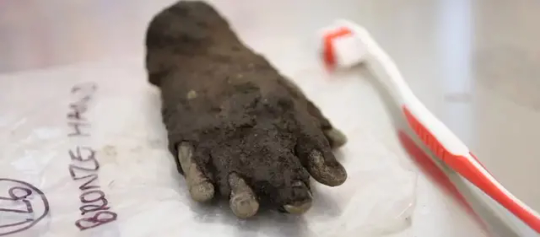
A Rare Bronze Hand Discovered in Vindolanda
One of Europe’s most important Roman archeological sites is the Fort of Vindolanda, one of the earliest Roman garrisons built by the Roman army in England. It was a Roman auxiliary near Hadrian’s Wall that guarded a major highway called the Stanegate.
Only a few weeks had passed since the start of the excavation season at Vindolanda when a remarkable artifact was discovered 1.5 meters below present-day ground level in the uppermost layers of the northern Severan ditch fill.
A small, child-sized, and eerily life-like bronze hand had been discarded in the ditch. Close inspection of the artifact after conservation at Vindolanda revealed that the 10cm hand originally had an attachment, now missing, inserted into the palm.
The hand is very well crafted, especially on the palm-facing side, indicating that its purpose was to profile the object that it once held. The base of the hand is socketed and would have been originally fixed to a pole.
The hand was uncovered some metres beyond a temple dedicated to Jupiter Dolichenus, tucked into the northern wall of the third-century fort at Vindolanda which was excavated in 2009.
The newly discovered hand most likely served a cult function and was possibly associated with Jupiter Dolichenus, a god and mystery cult that was popular in the Roman Empire from the early second to mid-third centuries AD.
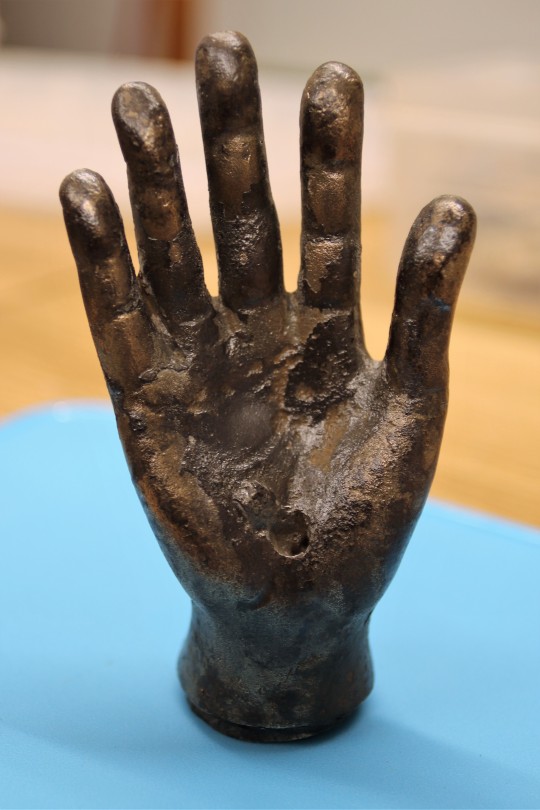
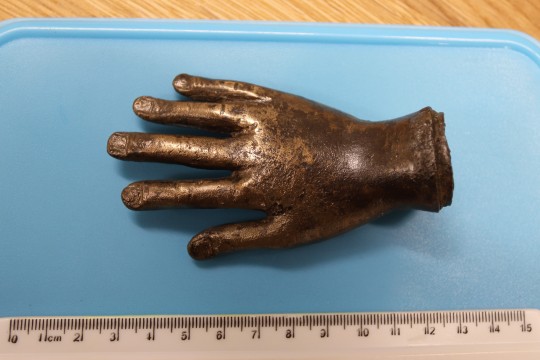
Similar votive hand specimens have been discovered in or near other Jupiter Dolichenus temples, though most are slightly larger than the Vindolanda specimen and some are fortunate enough to still have inscriptions mentioning the god.
Jupiter Dolichenus is depicted holding a thunderbolt in his hand with an upraised arm signifying his destructive power, the open votive hand symbolizes the protection and well-being that he could also bring.
The hand is now on public display in the same gallery as the altars dedicated to Jupiter Dolichenus at the Vindolanda Museum.
Between AD 85 and 370, nine timber or stone forts were built at Vindolanda, resulting in one of the most complex archaeological sites in Britain and a unique cultural legacy of frontier life.
Today, Vindolanda is an ongoing active archaeological site, with previous excavations uncovering thousands of perfectly preserved shoes, textiles, wooden objects, and the Vindolanda tablets (the oldest surviving documents in Britain that date from the 1st and 2nd century AD).
By Oğuz Büyükyıldırım.


#A Rare Bronze Hand Discovered in Vindolanda#Hadrian’s Wall#bronze#bronze sculpture#ancient artifact#archeology#archeolgst#history#history news#ancient history#ancient culture#ancient civilizations#roman history#roman empire#roman art#roman legion
165 notes
·
View notes
Text
Women found temporary, often short-lived support for the notion of their innate equality with men as creatures of God in the heretical sects. Women in great numbers were active in organizing and proselytizing for the heretical sects and were visible among those suffering persecution and martyrdom. In this, they followed a pattern already noted in the history of early Christianity: as long as movements were small, loosely structured and persecuted, women were welcomed as members, given access to organizational leadership and shared authority with men. When the movement became successful, it became more tightly structured, more hierarchical and more male-dominated. Women were then relegated to auxiliary roles and to invisibility. This can be illustrated by the case of the Cathars.
The Cathar heresy flourished in the 11th century in the Languedoc and in the 12th century continued there and spread into Italy, the Rhineland and the Low Countries. Its dualistic belief system rested heavily on Gnostic texts and interpretations. Cathar doctrine taught that there were two distinct gods, one the creator of good, the other of evil. The material world was created by the evil god and its reproduction was by definition evil, hence Cathars rejected marriage and what they defined as the fruits of copulation, meat and milk. Since sin originated in Satan, Cathars held Eve blameless in the Fall; they saw her merely as Satan's tool. Following Gnostic doctrine, Cathars believed that Mary Magdalen had been the wife or concubine of Christ. They denied the doctrine of physical resurrection and held that resurrection referred purely to the soul. It was the evil god that created male and female; in the heavenly kingdom all creatures would be angels without earthly sexuality. These doctrinal differences from Catholic orthodoxy enabled Cathars to see men and women as more alike than different in the divine purpose and in their religious potential. Cathars believed that it was possible for human beings to come closer to perfection through ascetic living; those who succeeded were called perfecti; both men and women could reach that stage. In practice most people reached that stage only shortly before their death. While marriage was tolerated for the ordinary believer, it was forbidden to perfecti and perfectae. One reached that stage through the ceremony of the consolamentum, a sort of baptism by the laying on of hands. This meant that ordinary believers had a great deal of freedom in sexual matters during their lifetimes, since they were assured that after confession and receiving the consolamentum they would be perfected and saved. It is significant for the high status of women among the Cathars that, at least in theory, men and women could administer the consolamentum, although in practice few women ever did.
Catharism developed in the cities of the Languedoc, especially in Toulouse, the center of textile production and trade. Large numbers of women in the textile manufacturies became Cathars, as did male artisans and textile workers. Since the wages of female textile workers were much below those of male workers, even fully employed women could barely support themselves. To such women Catharism may have offered hope of salvation and practical communal support. The disproportionately large number of females among these heretics was noticed even by contemporaries.
A number of Languedoc noblewomen are known as leaders of Catharism and as perfectae. Phillipa, wife of the Count de Foix, led a convent of perfectae; one of the count's sisters was Esclarmonde de Foix, the "Princesse Cathare." After the death of her husband, she returned to the court of her brother, who built a house in which she, his former wife and other perfectae lived. In 1207 there was a public dispute between several bishops and representatives of Waldensians and Cathars. It is indicative both of her high status and of the limitations of her position that Esclarmonde participated in this public dispute on the side of the heretics and that the bishops reprimanded her and told her to go back to her spinning.
In the second half of the 12th century many Cathar women's convents were founded for unmarried daughters and widows of the lower nobility. These communities, led by perfectae, were under the spiritual guidance of a heretical bishop. While these Cathar women, like Catholic nuns, were active in education, spinning and weaving, they also proselytized and performed some religious ceremonies.
Constant persecution of the Cathars by the Inquisition made severe inroads in the strength of the movement. The violence of the Albigensian crusade of 1209 fell with particular brutality upon women. That year there was a massacre of heretic women and children in Beziers, and a year later, in Minerve, Cathars were given a choice of abjuring their belief or burning. One hundred forty male and female Cathars jumped into the flames. When crusaders started a reign of terror against the perfectae, the local population at times defended the heretics. In 1234 in several communities, armed women and other citizens prevented the arrest of female heretics. In 1243 women actively fought in defense of Montsegur castle, the last stronghold of the Cathars. During the siege almost all the noblewomen in the castle made a pact with the bishop to give them the consolamentum in case they were wounded and could not speak. The agreement was fulfilled when the situation in the fortress became hopeless. After the defeat, the military defenders of the fortress were allowed to retreat unharmed, but 200 male and female Cathars were burned on a great pyre, among them a number of well-known perfectae. After Montsegur the nobility largely withdrew from Catharism, and Cathar convents gradually disappeared.
By the end of the 13th century, Inquisition records no longer mention perfectae, which indicates that they lost their leadership position in the sect. In its declining phase Catharism attracted more adherents of the urban middle classes. Members of the middle class were drawn to Catharism because it allowed profit and interest, which the Church opposed. The Cathar women among this group appear in the record as among the faithful, but not as leaders. They supported the movement by raising funds, giving help to fugitives and doing missionary work. With the destruction of the Cathar convents the opportunity for women to exercise autonomous power and even political leadership disappeared. Many former perfectae joined the Beguines; others found refuge in Catholic convents. By the middle of the 14th century, Catharism had virtually disappeared. As would happen so often later in revolutionary and heretical movements, Catharism had seemed to promise women a role of spiritual and theological equality. Under the impact of persecution and of middle-class respectability this promise had given way to male dominance and patriarchal structures. The courage of the armed women defending their villages in the Languedoc against invading crusaders was only a singular outcry, throttled, and quickly forgotten.
-Gerda Lerner, The Creation of Feminist Consciousness
#gerda Lerner#female spirituality#female oppression#patriarchy#male violence#asceticism#catharism#women’s history#religious history#inquisition#heretical women
26 notes
·
View notes
Text


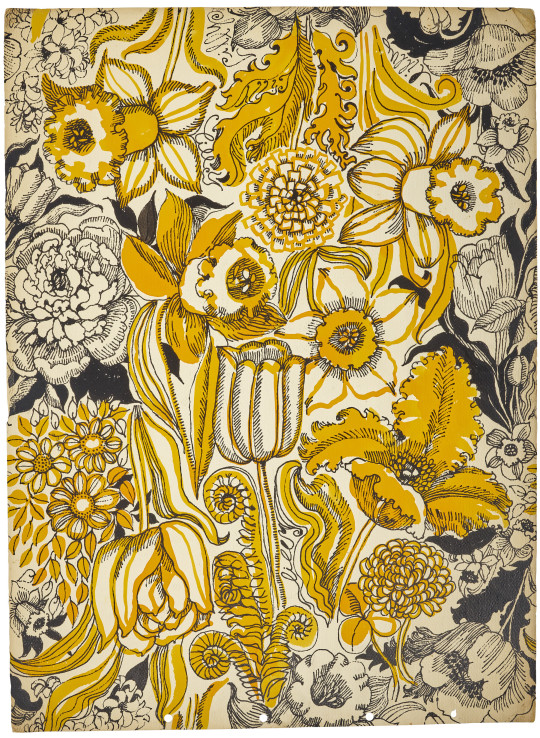
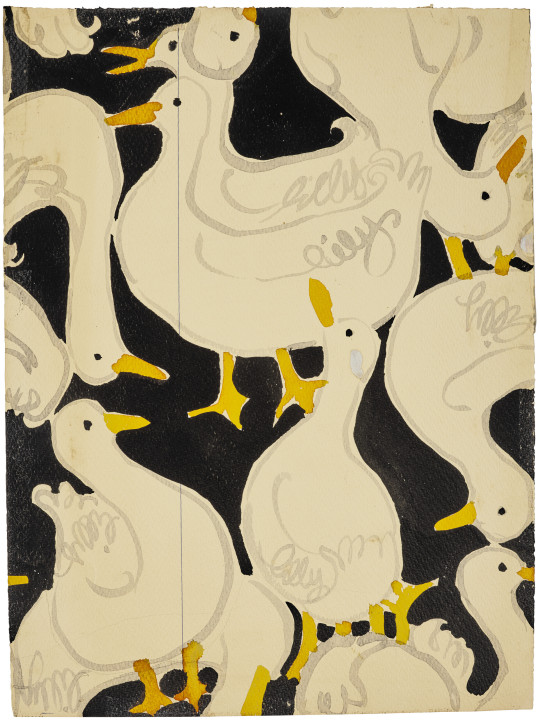



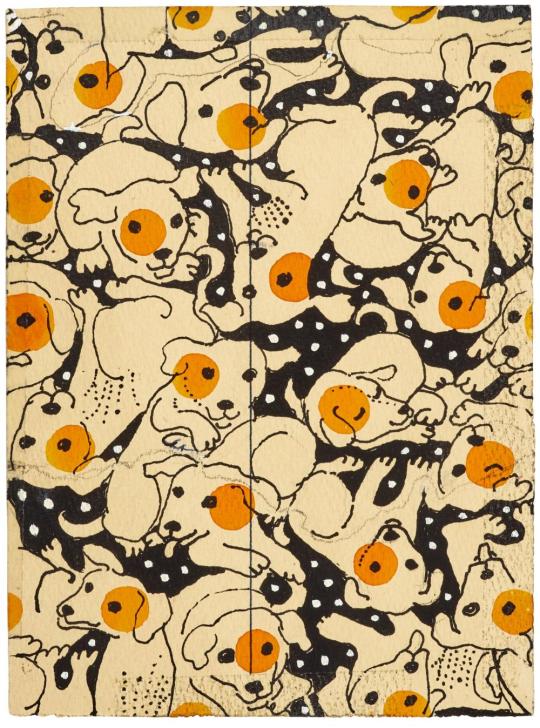
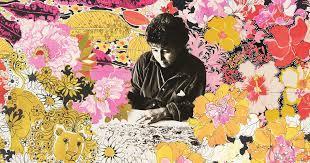
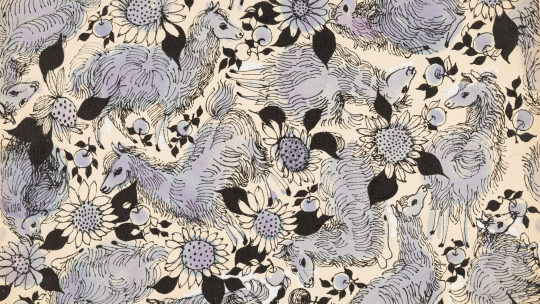
Textile designer SUZIE ZUZEK (American, 1920-2011)
“Suzie Zuzek is somebody whose work is familiar to millions of people, and who had a major impact on the social history and the material culture of the 1960s and ’70s, but most people have never heard her name,” said Cooper Hewitt textile curator Susan Brown.
"The road from basement obscurity to posthumous recognition was a long and winding one, spearheaded by a St. Louis lawyer named Becky Smith, who first encountered Zuzek’s designs while on the hunt for vintage upholstery fabric. She ended up in Key West and ran into Zuzek’s daughter, Martha, who shared her late mother’s story. Smith says she was captivated, and immediately made it her mission to bring the story to light: “What if your mom sat on the second floor of an art studio for a quarter of a century and created an iconic look through her creative genius and nobody knows her name?”
Born in 1920, Zuzek grew up on a dairy farm outside of Buffalo, New York. After serving in the Women’s Army Auxiliary Corps during World War II, she studied textile design and illustration at the Pratt Institute in Brooklyn. She graduated at the top of her class and worked for the New York-based fabric company Herman Blanc before relocating to Key West with her husband, from whom she separated not long afterwards. Eventually, she ended up with a job at Key West Hand Print Fabrics, a local outfit run by a group of former Broadway set designers.
“There are a lot of larger-than-life characters in the story, around her, but she herself was pretty quiet,” Brown said, recalling conversations she had with local residents for a short documentary that will accompany the exhibition. “I get the feeling she was more taciturn than shy. People say she had a really wicked sense of humour.”
https://www.wmagazine.com/.../suzie-zuzek-lilly-pulitzer...
63 notes
·
View notes
Text
What Are the New Inventions in the Textile Industry?

Innovation in the textile sector is surging thanks to developments in technology and the expanding need for sustainability.
These are a few of the most innovative new technologies that are revolutionizing the textile industry: Intelligent Textiles Electronic components are integrated into smart textiles, also known as e-textiles, to improve functionality.
Fit wear with integrated sensors to track vital signs and smart textiles that adjust color or temperature in reaction to environmental changes are examples of innovations.
Eco-Friendly and Sustainable Fabrics: Biodegradable and recycled materials are developed as a result of a strong emphasis on sustainability. Polyester that is bio-based and made from renewable resources like corn and sugarcane is durable while leaving less of an environmental impact.
Furthermore, by turning waste into new textiles, recycled fabrics—like those created from PET bottles or used clothing—support a circular economy.
Superior Textile Finishes: Durability and hygiene are being improved by new fabric treatments. Silver nanoparticle-treated antimicrobial textiles stop the growth of bacteria, and hydrophobic or photo catalytic coatings help self-cleaning textiles repel dirt and remove stains.
Weather-proof and UV-resistant materials shield outdoor textiles from the elements and UV rays, extending their lifespan.
Creative Methods of Production: Fabric creation is being revolutionized by advanced industrial techniques such as 3D knitting and printing. 3D knitting machines enable complicated designs and reduce waste by producing full clothes in one piece. Rapid prototyping and complex textile structures are made possible by 3D printing.
Without changing the feel of the fabric, nano textiles with nano coatings and nanofibers improve characteristics like strength, breathability, and stain resistance.
Textiles with Multiple Uses: Phase-change materials (PCMs), which control temperature by absorbing, storing, and releasing heat, are incorporated into new multipurpose textiles.
Thanks to the development of shape-memory alloys (SMAs), textiles may adapt to changes in shape and provide compression or fit depending on the wearer's actions and the surrounding environment.
Visit site
Contact
8866868394
Gmail
#textile dyes auxiliaries#textile finishing chemicals#textile finishing chemicals manufacturers#textile chemicals manufacturer#textile dyes manufacturers#textile auxiliaries#textile finishing chemicals suppliers#dyeing printing auxiliaries manufacturer#textile enzymes manufacturer
0 notes
Text
Both popular and academic anthropological writers have presented us with scenarios of human evolution that feature, almost exclusively, the adventures and inventions of man the hunter, man the toolmaker, man the territorial marker, and so forth. Woman is not comprehended as an evolutionary or evolutionizing creature. She is treated rather as an auxiliary to a male-dominated evolutionary process; she mothers him, she mates him, she cooks his dinner, she follows around after him picking up his loose rocks. He evolves, she follows; he evolutionizes, she adjusts. If the book jackets don't give us pictures of female Homo sapiens being dragged by the hair through 2 or 3 million years of he-man evolution, we are left to assume this was the situation.
This, despite the known fact that among contemporary and historic hunting-and-gathering people, as among our remote hunting-and-gathering ancestors, 75 percent to 80 percent of the group's subsistence comes from the women's food-gathering activities. This, despite the known fact that the oldest tools used by contemporary hunters and gatherers, and the oldest, most primal tools ever found in ancient sites, are women's digging sticks. This, despite worldwide legends that cite women as the first users and domesticators of fire. This, despite the known fact that women were the first potters, the first weavers, the first textile-dyers and hide-tanners, the first to gather and study medicinal plants i.e., the first doctors and on and on. Observing the linguistic interplay between mothers and infants, mothers and children, and among work-groups of women, it is easy to speculate on the female contribution to the origin and elaboration of language. That the first time measurements ever made, the first formal calendars, were women's lunar-markings on painted pebbles and carved sticks is also known. And it is thoroughly known that the only "God-image" ever painted on rock, carved in stone, or sculpted in clay, from the Upper Paleolithic to the Middle Neolithic—and that's roughly 30,000 years—was the image of a human female.
—Monica Sjöö & Barbara Mor, "The Great Cosmic Mother: Rediscovering the Religion of the Earth."
#feminism#radical feminism#radblr#marxist feminism#patriarchy#radfem#marxism#socialist feminism#monica sjöö
11 notes
·
View notes
Text
#auxiliaries for textile industry in Delhi#textile auxiliaries manufacturers Delhi#textile auxiliary producer Delhi
0 notes
Text
Chemical Manufacturers in Mumbai: Pioneering Excellence and Innovation
Mumbai, the bustling financial capital of India, is also a major hub for industrial and chemical manufacturing. The city hosts numerous chemical manufacturers in Mumbai who play a pivotal role in supporting various industries with high-quality chemical products and innovative solutions. In this blog, we delve into the world of chemical manufacturers in Mumbai, exploring their contributions, capabilities, and impact on the industrial landscape.
The Significance of Chemical Manufacturers
Chemical manufacturers in Mumbai are essential to a wide range of industries, including pharmaceuticals, textiles, agriculture, food processing, and more. They produce a diverse array of chemicals, from basic industrial chemicals to specialized formulations, ensuring the smooth functioning of production processes and the development of advanced products.
Mumbai: A Strategic Location
Mumbai’s strategic location with its port facilities, well-developed infrastructure, and proximity to raw materials makes it an ideal location for chemical manufacturers in Mumbai. The city’s robust industrial ecosystem provides manufacturers with access to a vast network of suppliers, distributors, and customers, facilitating efficient production and distribution.
Innovation and Technology
Chemical manufacturers in Mumbai are at the forefront of innovation, utilizing cutting-edge technology and research to develop advanced chemical solutions. They invest in state-of-the-art laboratories and R&D facilities to create new formulations that meet the evolving needs of various industries. This commitment to innovation ensures that chemical manufacturers in Mumbai remain competitive in the global market.
Quality Assurance
Maintaining high standards of quality is crucial in chemical manufacturing. Companies in Mumbai adhere to stringent quality control protocols to ensure the purity, consistency, and safety of their products. Many manufacturers are certified by international standards organizations, underscoring their commitment to quality and compliance.
Diverse Product Range
The chemical manufacturers in Mumbai offer a diverse product range, catering to different industrial requirements:
Pharmaceuticals: Active pharmaceutical ingredients (APIs), intermediates, and excipients.
Textiles: Dyes, pigments, and textile auxiliaries.
Agriculture: Fertilizers, pesticides, and growth promoters.
Food Processing: Food additives, preservatives, and flavor enhancers.
Industrial Applications: Solvents, adhesives, lubricants, and specialty chemicals.
Sustainability Initiatives
Environmental sustainability is a growing concern in the chemical industry. Many chemical manufacturers in Mumbai are adopting green chemistry principles, focusing on reducing waste, minimizing emissions, and using renewable resources. These sustainability initiatives reflect a broader commitment to environmental stewardship and social responsibility.
Market Leadership
Mumbai’s chemical manufacturers have established themselves as leaders both domestically and internationally. Their ability to provide high-quality products, customized solutions, and reliable services has earned them a reputation for excellence. They cater to a global clientele, exporting chemicals to various countries and contributing to India's position as a key player in the global chemical industry.
Conclusion
In conclusion, chemical manufacturers in Mumbai play a vital role in supporting and advancing various industries with their innovative solutions and high-quality products. Their strategic location, commitment to quality, and focus on sustainability ensure they remain at the forefront of the industry. For businesses seeking reliable chemical solutions, partnering with chemical manufacturers in Mumbai offers access to a wealth of expertise and advanced technology.
As the chemical industry continues to evolve, manufacturers in Mumbai are poised to drive growth and innovation, contributing to both local and global markets. Embrace the expertise and reliability of chemical manufacturers in Mumbai to enhance your operations and achieve lasting success in your industry.
0 notes
Text
How Textile Auxiliaries Manufacturers in India Are Shaping the Global Market

The textile industry is a cornerstone of the global economy, with India playing a pivotal role as one of the leading producers and exporters of textiles and garments. A crucial yet often overlooked component of this industry is the segment dedicated to textile auxiliaries. Textile auxiliaries are chemical substances used during various stages of textile processing, such as pre-treatment, dyeing, printing, and finishing. These auxiliaries enhance the quality, functionality, and aesthetic appeal of textiles. Textile auxiliaries manufacturers in India are making significant strides in this field, influencing the global market in numerous ways.
Innovation and Technology
Textile auxiliaries manufacturers in India are at the forefront of innovation and technological advancements. They invest heavily in research and development to create high-performance products that meet the evolving demands of the textile industry. Advanced technologies such as enzyme-based treatments, nano-coating, and eco-friendly chemical processes are being developed to improve the efficiency and sustainability of textile production. These innovations not only enhance the quality of the final product but also reduce environmental impact, making Indian manufacturers leaders in sustainable textile solutions.
Sustainable Practices
With increasing global awareness about environmental issues, there is a growing demand for sustainable and eco-friendly textile products. Indian manufacturers have responded to this demand by developing eco-friendly textile auxiliaries that minimize pollution and reduce the use of hazardous chemicals. For instance, biodegradable surfactants, low-impact dyes, and water-saving agents are some of the sustainable products being developed. These efforts align with global sustainability goals and position Indian manufacturers as responsible and forward-thinking leaders in the textile industry.
Competitive Pricing
One of the key advantages of textile auxiliaries manufacturers in India is their ability to offer high-quality products at competitive prices. The cost-effective production processes, coupled with the availability of skilled labor and raw materials, enable Indian manufacturers to provide value for money. This competitive pricing is a significant factor driving the global demand for Indian textile auxiliaries, making them attractive to textile producers worldwide who are looking to optimize their production costs without compromising on quality.
Customization and Versatility
Indian manufacturers are known for their ability to provide customized solutions tailored to the specific needs of their clients. Whether it is developing a unique dyeing auxiliary for a particular fabric or creating a finishing agent that imparts special properties to the textile, Indian companies excel in delivering versatile and customized products. This flexibility and responsiveness to customer needs enhance their reputation and reliability in the global market, attracting a diverse range of clients from various segments of the textile industry.
Strong Export Network
India’s strategic geographic location and well-established export network further bolster the position of its textile auxiliaries manufacturers in the global market. With efficient logistics and transportation systems, Indian companies can ensure timely delivery of their products to international markets. Additionally, trade agreements and favorable export policies facilitate smooth cross-border transactions, making it easier for Indian manufacturers to expand their reach and serve clients worldwide.
Quality Assurance
Maintaining high standards of quality is a priority for textile auxiliaries manufacturers in India. They adhere to stringent quality control measures and international standards to ensure that their products meet the highest levels of performance and safety. Certifications such as ISO, REACH, and OEKO-TEX are commonly obtained by Indian manufacturers, providing assurance to global clients about the quality and reliability of their products.
Collaboration and Partnerships
Indian textile auxiliaries manufacturers actively collaborate with global textile companies, research institutions, and industry associations to stay abreast of the latest trends and developments. These collaborations foster knowledge exchange, drive innovation, and open up new avenues for growth and expansion. By forming strategic partnerships, Indian manufacturers can leverage their expertise and resources to address global market challenges and opportunities effectively.
Conclusion
Textile auxiliaries manufacturers in India are playing a crucial role in shaping the global textile market. Through innovation, sustainable practices, competitive pricing, customization, and a strong export network, they are setting new benchmarks for quality and efficiency. Their commitment to excellence and adaptability to changing market demands position them as key players in the global textile industry. As the world continues to seek high-quality and sustainable textile solutions, the influence of Indian manufacturers is set to grow even further, solidifying their place as leaders in the global market.
0 notes
Link

Soaping agent plays an imperative role in the manufacturing process of dyed or printed textile. So, if you want to learn about soaping agents and want to know how it impacts textile manufacturing process, then this is the post for you.
0 notes